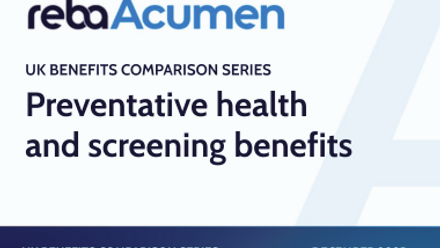Why employers need to act now in the fight against cancer
If you were to ask a colleague to name the number one lifestyle-related risk factor for cancer, there is a strong likelihood they would say, “smoking". And they would be correct.
Yet to assume that everyone knows this well-publicised fact, as well as other lifestyle-related risk factors for cancer and, moreover, that they adapt their lifestyle accordingly, would be a mistake. And for employers, it could be a costly one.
A 2024 study revealed that the potential cost of cancer absences to UK businesses was £1.6bn. But if we truly want to limit the escalating cost of cancer to employers, we need to begin long before diagnosis – right at the start of the cancer lifecycle, at prevention.
Preventative health education is now on the national agenda. The Department of Health and Social Care is currently consulting on a National Cancer Plan, which puts prevention at the top of a list of priorities aimed at improving cancer outcomes in the future, and smart employers are following suit.
In order to succeed, however, any cancer prevention plan – national or organisational – needs to begin by asking a fundamental question: what do people in various demographics already understand about cancer risk? And, even more importantly: what do they not?
The current state of lifestyle-related cancer risk factor awareness
Across May and June 2023, Perci Health partnered with Censuswide to survey 2,000 people from 16 to 55 and over about their understanding of cancer risk factors, as well as the degree to which they believe employers have a role in cancer prevention education.
The results can be summarised into two main insights:
- Many young people are unaware of key cancer risks, with a notable lack of awareness among men under 25
- Risk reduction and cancer awareness information is failing to reach key groups, leaving critical gaps in health education
Young men: the problem demographic
Let’s return briefly to the question we began with: the number one lifestyle-related risk factor for cancer? The survey revealed that if you directed this question to men aged 16-24, only 31% would have correctly identified smoking. This should definitely be of concern.
Despite a general decline in smoking over the last 20 years, 12% of UK people aged 18-24 smoke, and there’s been an 80% increase in cancer diagnoses in people under 50 over the past three decades.
Smoking is by no means an outlier when it comes to knowledge about cancer risk factors. The survey also showed that relatively few young men perceive sun exposure as a cancer risk factor (29% of men aged 25-34 compared to 55% of women the same age).
Only 25% of men aged 16-24 identified being overweight as a risk factor for cancer, and a shockingly low 10% of men the same age connect moderate alcohol consumption with cancer risk.
It’s not hard to see that a combination of lack of knowledge about cancer risk, coupled with high levels of engagement in risky behaviours, leads to only further escalation of cancer incidence rates in the future.
How should cancer prevention education evolve to meet different demographics?
Traditional cancer prevention measures, including smoking cessation and weight loss programmes, often focus on older members of the workforce, yet across the board, the survey results identified that the over 50s are the best informed about risk. It also showed that women are, in general, more knowledgeable than men.
The Cancer Prevention Plan would do well to understand these nuances as it outlines its policies, but in order to reduce future costs, employers must do the same.
Organisations with a younger workforce, and/or a predominantly male one, must centre cancer risk awareness and prevention programmes on them, because – as the survey showed – NHS information simply isn’t reaching them.
Young men told us that they have received risk reduction information via a variety of channels (including during healthcare appointments, via leaflets, brochures, text messages and email), yet they still have the least recognition of the main lifestyle-related cancer risk factors.
What can employers do?
The only way to move the needle on cancer prevention, and to mitigate the healthcare costs increasingly associated with it, is by making vital health information as accessible and relevant as possible.
Men and women of young working age believe most strongly that cancer education should happen in the workplace, and are in favour of it being integrated into workplace wellbeing programmes.
However, certain groups (e.g., older women) are more likely to come to employee wellbeing programmes with a better base level of knowledge than others, indicating that a narrower and more targeted approach is required in order to bring everyone’s awareness up to the same level.
As might be expected, digital solutions are leading the way in new cancer prevention education. To be successful, each age and gender group must be targeted with information in formats and on platforms that actually work for them.
Here are just a few features to look out for:
- Education and support in key target areas that align with your demographic, e.g., smoking cessation, alcohol consumption, and diet and exercise
- Good-quality, clinically-approved digital content for those aged 16–24, and content-rich mobile apps and email programmes for those aged 25+
- Virtual, clinical support for screening, including an ecosystem of reputable online content, e-learning and the ability to talk to cancer nurses for wrap around care and faster access to treatment pathways
While there is still a long way to go to move to a truly preventative and proactive healthcare system, I’m pleased to see more and more employers are taking up the cancer prevention mantle.
By being smart with what they deliver and how, I’ve no doubt that they’ll see a reduction in the number of staff impacted by cancer, and the costs associated with it.
Supplied by REBA Associate Member, Perci Health
Perci Health is the first digital platform bridging the gap between cancer and wellness.








